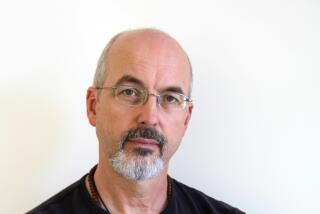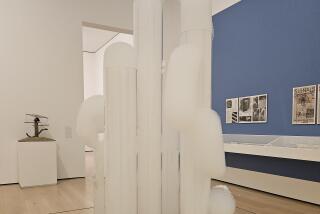Creating Art From a Diverse Heritage : Exhibit: Anish Kapoorâs ties to both East and West have helped him evolve into a sculptor who is being recognized worldwide.
LA JOLLA â Though known for his use of brightly colored pigment in exotically shaped sculptures, Anish Kapoor doesnât dress the part.
Wearing a plain gray shirt and gray jeans with zippers flapping open at the pockets, the artist broke away one day last week from supervising the delivery of his work to the San Diego Museum of Contemporary Art. Still, his demureness did little to hide the intellectual and international sophistication that governs his art.
Indian-born but a resident of London since the early 1970s, Kapoor, 37, has been recognized since the early 1980s for sculpture that has been praised and criticized for being patently beautiful.
Beginning in the late 1970s, he made biomorphic forms covered with brilliantly colored pigment. The pod-like elements, sometimes almost geometric but more often undefinable in their graceful, human-scale shapes, were made of hidden materials that made them seem unknowable: Sometimes he used plaster, some times wood or resin. All of them were coated with powdered color that made them look as seductive, yet untouched, as a blanket of freshly fallen snow.
Today, Kapoorâs work has become more concrete; he often cuts into enormous stone boulders and then colors the voids to create mystical spaces that seem endlessly deep.
As the enormous crates containing his latest carved-stone boulders were moved with a forklift across the plaza in front of the museum, Kapoor looked on with a mix of anxiety and satisfaction. The show, which opens Sunday, is his first major museum exhibition in the United States and his first exposure on the West Coast. The two years of stone works and multi-piece installations that will fill the museum represent the culmination of a decade of international exposure.
Small in stature but with a deep-throated voice distinguished by an upper-class British accent, Kapoor belies a mix of cultural backgrounds. He was raised in the foothills of the Himalayas in what he calls âa spectacular setting.â His mother, who also was raised in India, is a Jew of Iraqi heritage; his father, a Hindu, was a naval hydrographer.
Kapoorâs upbringing was cultured, colored by the Indian spirituality that seeps into every aspect of quotidian existence there. Nevertheless, his family was extremely secular, and, he said, âmore Jewish than Hindu.â
When it came time to find himself after finishing his lower schooling in India, Kapoor did something few Indian boys do: He went to Israel to live communally. While there, he tried to study engineering.
âLike any good Indian boy, I thought I would be an engineer,â Kapoor said with a throaty laugh. âIâd been making little things all along, but I never took them seriously. When I found that I hated engineering school, I decided I wanted to go to art school. So I moved to London,â a place he had never even visited.
As he sat down to talk in an office upstairs from the galleries, Kapoor fiddled briefly with--but never opened--a pack of Dunhill cigarettes, and as he described his life and work, he looked constantly away from the interviewer and out the window at the view of the La Jolla Cove just below.
âThe transition (to living in England) was very hard; there was the cultural change, but also being an art student. It was wonderful; I loved being an art student, but all through the time that I was, I had no real concept of being different from anyone else, in terms of my cultural background. It didnât even occur to me.
âThat might sound idiotic, but it wasnât until I left college, and decided in some way that I really did want to do this thing, which is called âbeing an artist,â that it suddenly hit me that the basis from which I was wanting to work was completely fluid. And I didnât know whether I was English or Indian or what.â
After graduating, Kapoor said, he returned for a visit to India and experienced an epiphany. His explorations of the duality of nature, which had been taking the form of installations influenced by the German artist Joseph Beuys, for one, suddenly made sense on a deeper, more personal level in his native land.
âI immediately recognized that all the things that Iâd been working with and thought came from different sources actually were innate to an Indian view, to the things Iâd grown up with,â Kapoor said.
Since then, he has both acknowledged and celebrated his Indian roots, pulling from Eastern spirituality, even as he explores very simple, modernist forms.
Yet he bristles at any kind of encapsulation, and often attempts to defy the very materials he uses.
âI have no sense of truth to materials,â Kapoor said of the powdery forms of his early work, which have been superseded by the newer, larger cut-stone sculptures. If anything, Kapoorâs art is about mystery, magical phenomenological experiences that defy naturalism.
As Kapoorâs work has evolved, he has moved from making objects to using objects to create a sense of inner space that often looks infinite. For example, in this show, Kapoor has sliced into a gallery wall to create a crevice. Filled with red pigment, the hole appears as a wound in the whitewashed surface. In another work, heâs carved a concave bowl into a boulder, using color to create an illusion of an endless, empty void within the shallow depth of the rockâs surface.
âIn the early works, the powder works were like icebergs, situated in the ground but partly revealed as objects, as if the rest of the object were below the ground. I see them as having an equivalent in the subconscious, as if they were sticking out of the subconscious,â Kapoor said. âPushing out, both physically and metaphorically.
âIn recent years, Iâve been involved in these vacant spaces, which I see as spaces of potential. The beginning rather than the end.â
Kapoorâs interests in psychology, philosophy and modernist formalism weave in and out of his talk, but he also continually points to the spiritual qualities of the work, which he sometimes willingly, sometimes reluctantly, links to his Indian heritage. Despite the fact that he has lived in London for nearly two decades, Kapoor continues to visit India annually.
He said he strives to find links to his heritage within his work, while still maintaining a dialogue with his Western contemporaries. It is within the context of the latter that he is always shown. Kapoor is considered a British sculptor, one of an increasingly well-known group that also includes Tony Cragg, Bill Woodrow, Antony Gormley and Richard Long.
But Kapoor is continually a foreigner, too, just as Salman Rushdie has remained both Indian and very much a Londoner.
âI have never shown work in India,â Kapoor said with evident chagrin. âAnd I know that Indian artists view me as a foreign artist. One is never just an outsider, or just an insider, youâre both simultaneously.â
Kapoorâs goal of imbuing his sculpture with his Indian sensibility is, in his mind, a way of striking new ground.
âI see very little contemporary art that is genuinely out of somewhere else. Most of it, even if it is made by non-European Western artists, seems to be mostly consumed by just one perspective. I see very little that actually is living one to the other. Itâs odd, actually, because that is not the condition of the world. Modernism has as much power in India as it has in New York--in architecture, in everything. The equivalence between East and West and the move between the two isnât so foreign. All the cultures live together.â
But try to pin him down on exactly what heâll agree is Indian about the art and he balks.
âThe spiritual link to Indian art, itâs something which I try to hold as a private world, rather than a part of my public world. It is something that is easily open to misunderstanding,â Kapoor said. âThere is a way in which Indian culture is so whole, it has such clarity, even today, of its world view, philosophically, in quotidian life, everything that one does is influenced by this atmosphere.â
One could easily argue that Kapoor has profited from both worlds. As an avowed multi-culturalist, he has been celebrated in an ever-broadening art world that wants to look beyond a Western ideal. But to celebrate just that side of the art, Kapoor insists, is to deny what he--the artist working in London, showing in New York, throughout Europe and now in La Jolla--has to offer.
âI think itâs very important to continually state that my being an Indian is very important to me, but it isnât the way I want what I do to be read. Itâs too bracketed.â
* âAnish Kapoorâ opens Sunday at the San Diego Museum of Contemporary Art, 700 Prospect St., La Jolla, and continues through May 31. A members â preview from 6-8 p.m. Saturday features the Charles McPherson Quartet, and will be open to the public for a nominal charge. Museum hours are 10 a.m. to 5 p.m. Tuesday-Sunday, until 9 p.m. Wednesday. After its run in San Diego, the show, organized by SDMOCA curator Lynda Forsha, will travel to Des Moines, Iowa, Ottawa and Toronto .
More to Read
The biggest entertainment stories
Get our big stories about Hollywood, film, television, music, arts, culture and more right in your inbox as soon as they publish.
You may occasionally receive promotional content from the Los Angeles Times.










